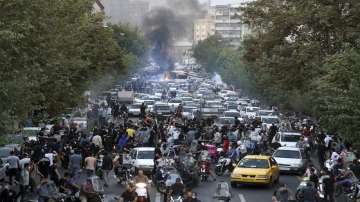Iran: Death toll mounts to 26 as violent protests continue over Kurdish woman's death in police custody
Iran protest: A young Kurdish woman's death in police custody has sparked sharp condemnation from Western countries and the United Nations and touched a national nerve.

Iran protest news: As many as 26 people may have been killed in the protests that followed after the death of a young woman in police custody, Iranian state TV suggested on Friday. This can be considered the widest unrest since 2019 when rights groups said hundreds of people were killed in a violent crackdown.
An anchor on state TV said late Thursday that 26 protesters and policemen had been killed since the protests erupted last Saturday after the funeral of the 22-year-old Mahsa Amini, without elaborating on how authorities reached that figure. He said official statistics would be released later, but in past times of turmoil, the Iranian government has not offered official death tolls. The unrest has killed at least 11 people according to a tally by The Associated Press, based on statements from state-run and semiofficial media.
Meanwhile, the country has also disrupted internet access to the outside world, according to internet traffic monitor Netblocks, and tightened restrictions on popular platforms used to organise rallies like Instagram and WhatsApp.
What is the reason for the crisis?
The crisis unfolding in Iran began as a public outpouring over the death of Amini, a young woman from a northwestern Kurdish town who was arrested by the country's morality police in Tehran last week for allegedly violating its strictly-enforced dress code. The police said she died of a heart attack and was not mistreated, but her family has cast doubt on that account.
Amini's death has sparked sharp condemnation from Western countries and the United Nations and touched a national nerve. Hundreds of Iranians across at least 13 cities from the capital, Tehran, to Amini's northwest Kurdish hometown of Saqez, have poured into the streets, voicing pent-up anger over social and political repression. Authorities have alleged that unnamed foreign countries and opposition groups are trying to foment unrest.
“The death has tapped into broader antigovernment sentiment in the Islamic Republic and especially the frustration of women,” wrote political risk firm Eurasia Group, noting that Iran's hardliners have intensified their crackdown on women's clothing over the past year since former judiciary chief Ebrahim Raisi became president.
What is the current situation in Iran?
The scenes of women cutting their hair and burning their hijabs feed into a broader political debate over the role of religious strictures in a modern-day republic — questions that have plagued the Islamic Republic since its founding in 1979. But the protests have also grown into an open challenge to the government. The chants have been scathing, with some calling for the downfall of the ruling clerics. The protesters cry, “Death to the dictator!” and “Mullahs must be gone!”
Thousands of women in traditional black chadors and men dressed in the style of the Basij, a volunteer force under the paramilitary Revolutionary Guard, poured into the streets after Friday prayers to vent their anger over the unrest, state-run IRNA news agency reported. “Death to America!”, “Death to Israel!" and “America's mercenaries are at war with religion!", they chanted.
Iran's govt threatens citizens against joining rallies
Iran's intelligence ministry warned citizens against joining “illegal” street rallies on Friday, threatening prosecution. Local officials have announced the arrest of dozens of protesters. Hasan Hosseinpour, deputy police chief in the northern Gilan province, reported 211 people detained on Friday. The government of the western Hamadan province said 58 demonstrators had been arrested. Tehran University announced that it would move classes online for the next week amid the unrest, the semiofficial Fars news agency reported.
Iran has grappled with waves of protests in the recent past, mainly over a long-running economic crisis exacerbated by American sanctions linked to its nuclear program. In November 2019, the country saw the deadliest violence since the 1979 Islamic Revolution, as protests erupted over a rise in the state-controlled price of gasoline.
Economic hardship remains a major source of anger today as the prices of basic necessities soar and the Iranian currency declines in value.
The Biden administration and European allies have been working to revive the 2015 Iran nuclear accord, in which Iran curbed its nuclear activities in exchange for sanctions relief, but the talks have stalled for months.
(With inputs from AP)
ALSO READ | Iran President Ebrahim Raisi refuses interview with US journalist after she refuses to wear hijab
ALSO READ | Iran: Women take off Hijab, protest Mahsa Amini's death after detention by 'Morality Police' | VIDEO